Talking shop with cops
Alumni in law enforcement give the 411 on reality versus fiction when it comes to their jobs.
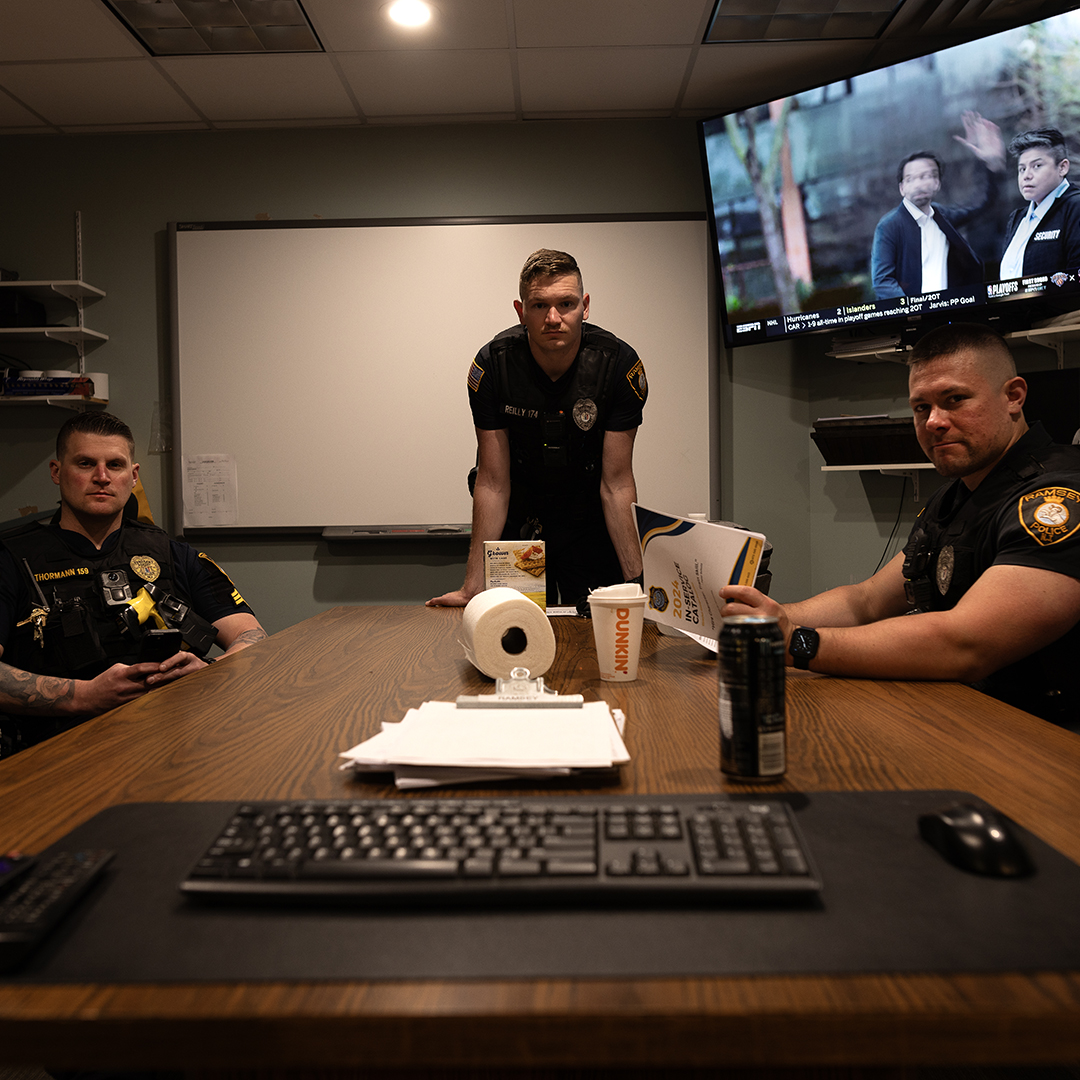
Sergeant Michael Thormann ’08, Officer Timothy Reilly ’20, and Officer Christopher Finn ’18 at the police station in Ramsey, New Jersey.
The police drama has been a popular staple of American television since Dragnet pioneered the way in the early 1950s. We are pulled to the investigative mysteries, the high-speed chases, the courtroom dramas, and even the real-life news stories that portray police officers — depending on events — as either heroes or villains. But as police have come under scrutiny in the 21st century, we wondered: How accurately do these shows reflect the reality of the job?
We turned to our alumni network of law enforcement officers to explore what it means to be a police officer today. We also spoke to professor Michael Mitchell to help us understand what the cop shows get right and wrong.
Michael Mitchell
Professor of criminology and African American studies
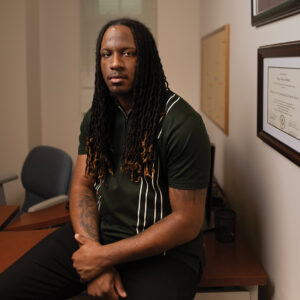
Mitchell grew up in the Dallas suburb of Garland, Texas, where his devotion to shows such as Law and Order and CSI led him to get involved with the Dallas Police Explorers, a police academy for youth and young adults interested in law enforcement careers. “I was about 11 years old,” Mitchell says. “I looked at police officers as superheroes. I saw them as going into dangerous situations, helping people in need. I was attracted to the entertainment, the excitement, the adrenaline rush — serving arrest warrants, investigating crime scenes, seeing cases adjudicated in court.”
That interest never wavered. After Mitchell graduated from Texas Southern University with a degree in administration of justice, he went to work as a corrections officer at the Dallas County jail, and later as a police officer in his hometown of Garland. But he found the daily reality of police work often conflicted with both his long-held perceptions and his academy training. He went on to earn a doctorate and pursue a career in academia. “Now, as an educator, I do the best I can to ensure that students and the public understand the realities of the entire criminal justice apparatus,” he says.
Officers Timothy Reilly ’20 and Christopher Finn ’18 and Sergeant Michael Thormann ’08
Ramsey New Jersey Police Department
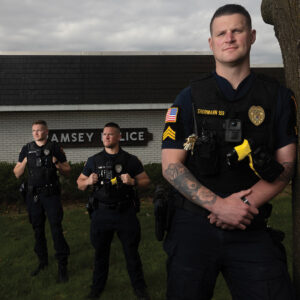
Thormann, Finn, and Reilly say TV cop shows get one thing right: the camaraderie among officers. “I look forward to shifts,” says Reilly. “We are friends for life.”
Happenstance brought this band of TCNJ brothers together on the same municipal police force. All three were athletes at TCNJ — Thormann and Finn played football, while Reilly was on the track and field team. “Having this TCNJ bond,” says Thormann, who supervises Finn and Reilly, “means I know these guys are smart cops.”
As patrol officers, Finn and Reilly say they respond to their share of non-violent routine calls but may also respond to more serious concerns, like domestic violence. And, although both say they don’t watch many police shows, Finn does enjoy On Patrol: Live, in which camera crews go on police ride-alongs, because the show allows him to see how departments around the country operate.
What do shows get most wrong? The paperwork. Or rather, the lack of it seen on screen. “That’s the biggest shock to new officers,” Thormann says. “When I see a car chase or an arrest on TV, I just think, ‘That’s a lot of report writing.’ Also, there’s no need to shout the Miranda warning — but it makes for good TV.”
MICHAEL MITCHELL SAYS:
There’s a false perception that the Miranda warning, which informs detainees of their right to remain silent and their right to an attorney, must be read in the course of making an arrest. In fact, police officers need only read Miranda rights before questioning a detainee.
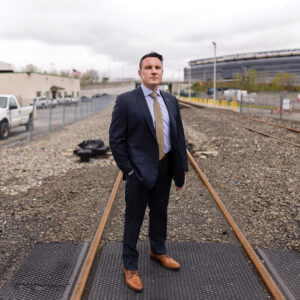
Captain Frank Robina ’01
New Jersey State Police
In his work as a state police detective, Robina learned firsthand that not all crimes are solved as quickly as depicted on television. One cold case that Robina helped investigate ended in 2022 with the identification of a 17-year-old girl (whose body had been found in a cemetery in Blairstown, New Jersey, 40 years earlier) and the arrest of her suspected killer. The state police solved that case, which was featured on the television shows Missing and America’s Most Wanted, with the aid of genetic genealogy. In fact, Robina says, the technology now used in investigative cases, especially long-cold cases, represents a major change he’s seen in detective work during his 23 years with the state police.
The son of a Paterson, New Jersey police officer, Robina entered the state police academy a month after graduating from TCNJ. In his wide-ranging career, he’s patrolled Interstate 80 and the byways of rural Sussex County. He spent 12 years as a detective in the Major Crime Unit of the Criminal Investigations Bureau, investigating murders and the use of fatal force by police officers. He was ultimately promoted to Captain and oversaw units investigating major crimes and cold cases, as well as tracking fugitives and missing persons. “There is a lot to learn,” he says of detective work. “It’s like putting pieces of the puzzle together.”
Today, Robina is the executive officer of the newly formed Port Security Section, which enhances the security mission at the New Jersey ports of Bayonne, Elizabeth, and Newark. He has high praise for his state police colleagues. “We want to make a positive impact in the community and embody our core principles of honor, duty, and fidelity.”
MITCHELL SAYS:
In television shows, violent offenses such as murder and sexual assault are typically solved within an episode. But most crimes are not even reported, and for those that are, many go unsolved. Several factors can influence the solvability of a case, including whether witnesses were present and how credible they are; what the weather conditions were; whether security camera footage is available; and what physical evidence (such as fingerprints, hair, clothing, and blood) has been collected.
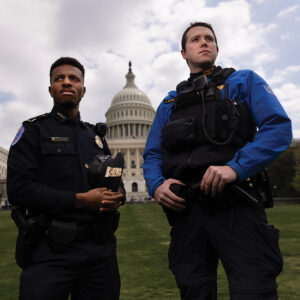
Ryan Parker ’19 and Joseph Martorano ’21
United States Capitol Police Officers
On most days, Parker works in the chamber of the United States House of Representatives, inside the U.S. Capitol, keeping lawmakers and their staff safe and helping members of the public navigate the building. “What I love about my job is the sense of mission,” he says. “It’s a job that brings me a lot of satisfaction.”
On January 6, 2021, Parker was inside the Capitol when hundreds of protesters entered the building in an effort to prevent Congress from certifying the 2020 presidential election results. Television cameras broadcasted the scenes to millions of viewers across the country and showed the Capitol Police officers being attacked in the melee. “You go through six-and-a-half months of training to try to prepare yourself for possible situations you encounter day to day,” Parker says. “But a situation like that is beyond what your training has called for.”
Parker, the son of a police officer, downplays his role on that day — “I played the part I was supposed to play” — but he remembers the aftermath. He saw his colleagues grapple with what had transpired. Some resigned. “Experiencing that — it’s tough,” Parker says.
Among Parker’s current colleagues is Martorano, who was still a TCNJ senior when the January 6 riot unfolded. While he was troubled by the events of that day, he says, “I was not going to let January 6 interfere with my ultimate goal.” He entered a federal law enforcement academy in August 2021, three months after graduating from TCNJ. Now he patrols the grounds outside the Capitol, frequently interacting with tourists visiting Washington, D.C. for the f irst time. Mindful of the scrutiny that law enforcement faces today, Martorano says he makes a conscious effort to treat the public with respect. “That’s my way of improving the public perception,” he says. “You show them respect, and they’re going to show that respect right back to you.”
MITCHELL SAYS:
We seldom see police in television dramas involved in political matters, but throughout American history, police have played a role during times of social unrest.
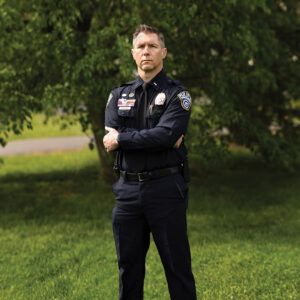
Lieutenant Steve Troyano ’98
Arlington County Police Department
In his 23 years in the Arlington County (Virginia) Police Department, Troyano has seen it all. He directed traffic after a jetliner hit the Pentagon on September 11, 2001, and was called to serve during a series of sniper killings in and around Washington, D.C. in October 2002. And as supervisor in
the Civil Disturbance Unit, he was part of one of the first mutual aid teams to arrive at the U.S. Capitol on January 6, 2021.
But Troyano would like to be remembered for one particular story: He delivered a baby in the back seat of a car. “I studied law and criminal justice at TCNJ and got a master’s degree in forensic science from George Washington University, but there are some things you are never prepared for,” he says with a laugh.
Troyano chose law enforcement due to his desire to make a difference in his community. His work has grown more challenging since 2014, when tensions between police and residents of Ferguson, Missouri, erupted following the shooting death of Michael Brown, an unarmed Black man. Over the next decade, similar scenarios would play out in communities across the nation, often fueled by the preponderance of social media. “One of the hardest things is that my relationship with my community can be impacted by someone making a poor decision elsewhere,” says Troyano. “The police–community relationship is the most effective tool we have. We need to invest our efforts in the next generation of officers to keep building those bridges with our community.”
MITCHELL SAYS:
It’s important to address the sort of police wrongdoing we see reported because it can erode public confidence and hinder the ability of police to keep communities safe. When the legitimacy of police is in question, when it no longer exists, you no longer have community support. How can police officers be effective in fighting crime when the community does not trust them?
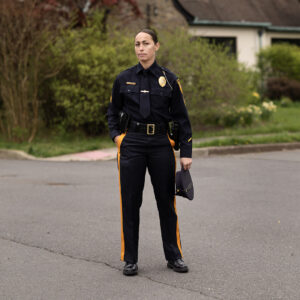
Sergeant Caitlin Hurley ’10
Ewing Police Department
For Hurley, law enforcement is a family affair: Both her parents, three uncles, and a cousin were state troopers. Her husband is currently in the state police, and her sister is a municipal police officer.
It’s no surprise, then, that when Hurley was growing up, she saw police as the good guys. Today, she realizes that’s not always the case or the public perception, and that understanding has guided her own work as a police officer. Hurley started as a patrol officer, responding to all manner of calls. “People say being a woman officer must be hard,” says Hurley, one of just a handful of women on Ewing’s 70-officer police force. “No matter whether you’re a female or a male, I think this job isn’t for everyone. It’s very demanding. You see things that most people don’t see.” Hurley says she tries to treat people she encounters on the job as she would like her own family to be treated.
Last year, Hurley was transferred to the department’s Community Relations Unit, which allows her to interact with the community in a variety of ways. She spends time in local schools teaching children how to stay safe in public. She’s supervised winter coat drives, and, in Ewing schools, she’s taken part in the D.A.R.E. program, teaching students how to stay away from illegal drugs.
More recently, she’s helped organize the department’s new Citizens Academy, which is intended to form positive partnerships between the department and the public. Anyone 18 years and over can apply to join the academy, which provides 24 hours of classroom instruction about all aspects of the Ewing Police Department. “This is the good side of policing,” Hurley says of the Community Relations Unit. “We get to make people smile. I’m ‘Sergeant Cait,’ as opposed to ‘Sergeant Hurley.’ I get lots of high fives and hugs.”
MITCHELL SAYS:
Television almost invariably portrays big-city police departments. In reality, nearly half of municipal police agencies employ no more than 10 officers.
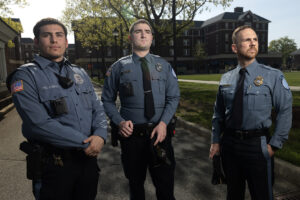
Officers Jorge Fallas ’23 and Andrew Iannaccone ’23 and Lieutenant Matthew Mastrosimone ’02
TCNJ Police Department
One of Mastrosimone’s favorite parts of his job as a TCNJ police officer is showing first-year students that not all cops are the tough-as-nails types so often portrayed on television. “The public doesn’t realize the empathy of law enforcement,” he says. “We come across as very straight and narrow and don’t want to show emotions.”
But being on a college campus, he says, much of his job is creating a safe community. “We have a great age group, the 18- to 22-year-old demographic, and the majority have never had any kind of law enforcement interaction,” Mastrosimone says. “For us to be able to show them that interaction in a positive way — to show them the human side, and laugh with them — is priceless.”
Mastrosimone joined the campus police after graduating 22 years ago, and today, he’s one of three TCNJ graduates on the force. Iannaccone started on the job his senior year; today, he’s also an MBA candidate at TCNJ. Fallas, who sat next to Iannaccone at their TCNJ graduation
ceremony, started on the force earlier this year. “I’ve always had people supporting me, almost like guardian angels by my side,” Fallas says. “Honestly, I just wanted to do that for other people. Whatever the situation may be, I would like to be there for someone.”
MITCHELL SAYS:
Some studies find more than 70% of police work consists of unassigned time in which officers are not actively responding to calls for service.
Photos by Matthew Aaron Callahan
Posted on May 30, 2024

